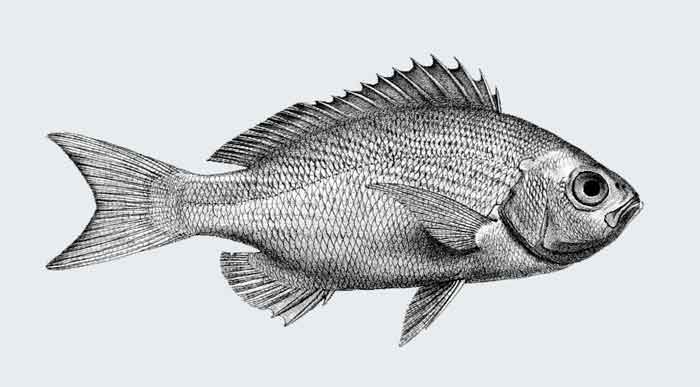Superregnum: Eukaryota
Cladus: Unikonta
Cladus: Opisthokonta
Cladus: Holozoa
Regnum: Animalia
Subregnum: Eumetazoa
Cladus: Bilateria
Cladus: Nephrozoa
Superphylum: Deuterostomia
Phylum: Chordata
Subphylum: Vertebrata
Infraphylum: Gnathostomata
Megaclassis: Osteichthyes
Superclassis/Classis: Actinopterygii
Classis/Subclassis: Actinopteri
Subclassis/Infraclassis: Neopterygii
Infraclassis: Teleostei
Megacohors: Osteoglossocephalai
Supercohors: Clupeocephala
Cohors: Euteleosteomorpha
Subcohors: Neoteleostei
Infracohors: Eurypterygia
Sectio: Ctenosquamata
Subsectio: Acanthomorphata
Divisio/Superordo: Acanthopterygii
Subdivisio: Percomorphaceae
Series: Eupercaria
Ordo: Lutjaniformes
Familia: Lutjanidae
Subfamilia: Lutjaninae
Genus: Pinjalo
Species: P. lewisi – P. pinjalo
Name
Pinjalo Bleeker, 1873
Type species: Caesio pinjalo Bleeker, 1850
References
Pinjalo – Taxon details on Integrated Taxonomic Information System (ITIS).
Pinjalo species list in FishBase,
Froese, R. & Pauly, D. (eds.) 2024. FishBase. World Wide Web electronic publication, www.fishbase.org, version 02/2024.
Vernacular names
日本語: セダカタカサゴ属

Pinjalo pinjalo
Pinjalo is a genus of marine ray-finned fish, snappers belonging to the family Lutjanidae. They are native to the Indian Ocean and the western Pacific Ocean
Taxonomy
Pinjalo was created as a monotypic genus by the Dutch physician, herpetologist and ichthyologist Pieter Bleeker, it was a monotypic genus containing only Bleeker's Caesio pinjalo, which he had Species description described in 1850. A second species, P. lewisi was added in 1987.[1] The generic name Pinjalo is derived from a Malay word for a fish pinialo.[2] The genus is classified within the subfamily Lutjaninae.[3]
Species
The following two species are classified within the genus Pinjalo:[4]
Pinjalo lewisi J. E. Randall, G. R. Allen & W. D. Anderson, 1987 (slender pinjalo)
Pinjalo pinjalo (Bleeker, 1850) (pinjalo)
Characteristics
Pinjalo snappers are medium-sized snappers and have moderately deep bodies with a comparatively small heads and a pointed snout. The eyes are placed in the middle of each side of the head. They have small teeth in their jaws with no enlarged cacine like teeth. The vomerine teeth and the palatine teeth are tiny. The dorsal fin is continuous, with no notch in the vicinity of the junction of spiny and soft-rayed part of the fin. The dorsal fin has 11-12 spines and 13-14 soft rays while the anal fin has 3 spines and 9-10 soft rays. The pectoral fins are long, extending as far as the anus, containing 17-18 fin rays and the caudal fin is emarginate. The overall colour is pink or red on the upper body, whitish or silvery on the lower flanks and abdomen, with fins which may be reddish, pink, yellow, or whitish, frequently with thin dusky margins.[5]
Distribution and habitat
Pinjalo snappers are found in the tropical waters of the Indian Ocean and the Western Pacific Ocean. They can be found on reefs and rocky substrates as deep as around 60 m (200 ft).[5]
Biology
Pinjalo snappers are predatory fish, feeding on benthic and planktonic invertebrates, and may also feed small fishes.[5] They may form large schools.[6]
Fisheries
Pinjalo snappers are important to artisanal fisheries in some parts of their range and are potentially exploitable more widely. They are mostly caught using handlines, traps and bottom trawls. The flesh is of considered to be of good quality and is usually sold fresh.[5]
References
Eschmeyer, William N.; Fricke, Ron & van der Laan, Richard (eds.). "Genera in the family Lutjanidae". Catalog of Fishes. California Academy of Sciences. Retrieved 27 June 2021.
Froese, Rainer; Pauly, Daniel (eds.) (2021). "Pinjalo pinjalo" in FishBase. February 2021 version.
J. S. Nelson; T. C. Grande; M. V. H. Wilson (2016). Fishes of the World (5th ed.). Wiley. p. 458. ISBN 978-1-118-34233-6.
Froese, Rainer and Pauly, Daniel, eds. (2021). Species of Pinjalo in FishBase. February 2021 version.
Gerald R. Allen (1985). FAO species catalogue Vol.6. Snappers of the world An annotated and illustrated catalogue of lutjanid species known to date (PDF). FAO Rome. pp. 138–139. ISBN 92-5-102321-2.
Bray, D.J. (2019). "Pinjalo lewisi". Fishes of Australia. Museums Victoria. Retrieved 28 June 2021.
Retrieved from "http://en.wikipedia.org/"
All text is available under the terms of the GNU Free Documentation License

